
by Rick O'Connor | Apr 29, 2017
I received a call the week before Earth Day to let me know that an alligator was laying on Pensacola Beach, on the Gulf side, near the gate to Ft. Pickens. This is certainly not something you see every day.

Alligator basking on the Escambia River; photo: Molly O’Connnor
Two questions came up…
One, Is this weird?
Two, Can alligators tolerate salt water?
Let us start with question 1 – is this weird?
Actually, it is not as weird as you may think. Alligators have been found on barrier islands of the northern Gulf of Mexico for decades. I myself have seen them at Big Sabine (though it has been many years since I saw one). As a student at Dauphin Island Sea Lab, we found them on Dauphin Island and on Petit Bois Island in Mississippi; I am sure they are on Horn Island in Mississippi as well. It is listed on the Gulf Islands National Seashore guide as one of the animals you may encounter in the park. They have been reported in the dune lakes of Walton County, and I have seen them at St. Andrew’s State Park in Panama City. So yea, they are found in our coastal areas – even the barrier islands. However, they do prefer the freshwater bodies of water on these islands. Which brings up the second question…
Question 2 – can they tolerate salt water?
The quick answer is yes, for a period. There are several reptiles in Florida that can tolerate periods of seawater. Those who spend long periods in brackish to marine waters have lachrymal glands to remove and excrete salt from their blood stream. This keeps the cells of their body in a more “fresh” environment and thus, can tolerate salt water for longer periods. Marine turtles, the most salt tolerant of all reptiles, excrete this salt through these glands located near their eyes. This gives them the appearance of “tears” or “crying” when they are on land. They are actually secreting salt from their body.
Alligators do not have well developed lachrymal glands. However, their tough skin is impermeable to absorbing seawater. They have thinner areas of skin where saltwater can enter and of course they can swallow seawater. Because of this, they cannot tolerate seawater very long and must eventually return to freshwater.
Alligators, like most Florida reptiles, do have to bask on land to warm their bodies in the morning. This is needed for proper digestion as well as other functions. It is also another way that alligators can avoid salty water for periods of time. I understand the alligator still had the faint yellow cross bands on its tail, indicating a younger animal, who may have wondered into the wrong location.
As far as being a danger to humans, you have to “read” the animal. Wild alligators have a natural fear of humans and would prefer to avoid us. According to the FWC, there have been 388 alligator attacks on Floridians since 1948, about 6 per year. 263 of those were considered “major” attacks, about 3 per year. 24 were fatal, about 0.4 per year (1 every 3 years). Wild alligators can be a problem if
- The animal is very large – it will consider larger prey like humans
- Attacking a pet (even on a leash) and indirectly attacking the pet owner
- Swimming in bodies of water with large alligators, especially at night (when they most often feed)
- The person was near a nest or young – alligators are very defensive of their young and nest
Any alligator can become a problem when fed. They lose their natural fear of humans and see us as a source of easy food – though they more often go after our pets, which are easier; they are more willing to approach us looking for an opportunity. Thus, is against Florida law to feed alligators.
I am not sure whether the alligator seen that week was acting aggressively or not but certainly could have been a problem. A “nuisance” alligator is defined by FWC as one being larger than four feet and acting aggressively towards humans or pets. If this is the case, they have a team of trappers who will come to collect the animal. It is not recommended that individuals try to capture these animals. As with snakes, many people bitten by alligators were trying to either catch them or kill them. It is best to leave this to the professionals.
Though it is a bit nerve racking to see an alligator on the beach, they are part of Florida’s environment. Like sharks swimming along our shores, alligators should not be approached but rather contact a local authority to alert them of the possible danger.
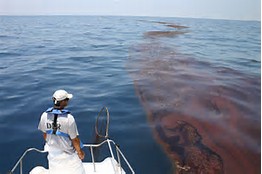
by Rick O'Connor | Apr 14, 2017

The Deepwater Horizon Oil Spill was one of the worst natural disasters in our country’s history.
Photo: Gulf Sea Grant
We are pleased to announce the release of a pair of new bulletins outlining how the 2010 Deepwater Horizon oil spill impacted the popular marine animals dolphins and sea turtles. To read these and other oil spill science publications, go to http://gulfseagrant.org/oilspilloutreach/publications/.
The Deepwater Horizon’s impact on bottlenose dolphins – In 2010, scientists documented a markedly increased number of stranded dolphins in the northern Gulf of Mexico. Was oil exposure to blame? Could other factors have been in play? Read the answers to these questions here: http://masgc.org/oilscience/oil-spill-science-dolphins.pdf.
Sea turtles and the Deepwater Horizon oil spill – This publication reviews the estimated damage oil exposure caused to sea turtles and discusses continued research and monitoring efforts for these already endangered and threatened species. Click here to read this bulletin: http://masgc.org/oilscience/oil-spill-science-sea-turtles.pdf.
Also –
“Sea turtles and oil spills” presentations – On March 23 in Brownsville, Texas, more than 100 participants gathered in person and online to listen to scientists, responders, and sea turtle specialists explain what we know about how these creatures fared in 2010 and detail ongoing conservation programs. Watch videos of the presentations here: http://gulfseagrant.org/sea-turtles-oil-spills/.
Our oil spill science outreach team hopes you will find these resources useful! J
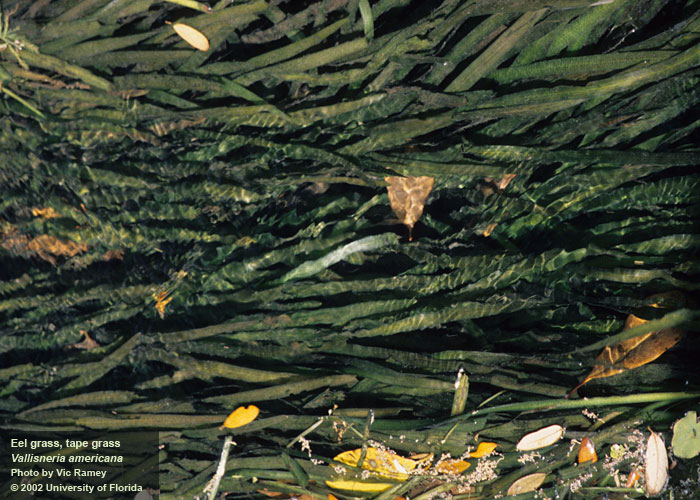
by Rick O'Connor | Apr 14, 2017
Article by Gadsden County Extension Agent
DJ Zadarreyal
Vallisneria americana, also known as tape grass or eel grass, is a common native aquatic weed in the state of Florida. Tape grass has tall, grass-like leaves that are a light green in coloration and rise vertically from the crown to the top of the water. Once the leaves reach the top of the water, they casually float along the surface.
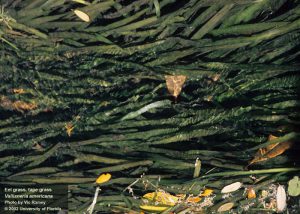
Common tape grass Vallisneria americana.
Photo: UF IFAS
The technique of propagation is by runners. These runners grow out from the crown along the sand and new plants arise from the end of them. There are separate male and female plants, although they grow on the same plant. The female flowers are on lengthy stems, which reach to the surface. However, the male flowers are loosely attached at the base of the leaves. When released, the male flowers float to the surface where they move alongside the female flowers to fertilize them.
A good way to distinguish tape grass from other weeds is to observe the leaves and the tips. Tape grass have round leaf tips while many other weeds have pointed leaf tips. In addition, tape grass is a submerged weed that possesses long, ribbon like leaves.
There are several uses for tape grass. Restoration of the pond floor is a useful purpose. One of the benefits of tape grass is that they are great oxygenators. Tape grass is also a common home based aquarium plant. They provide an eye-catching scene that fish and humans enjoy.
Source:
Guide of Tropical Fish, Everything You Need to Know About Tropical Fish
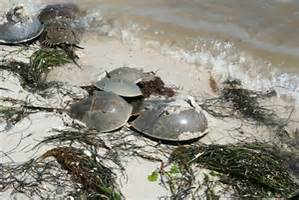
by Rick O'Connor | Apr 14, 2017
Growing up in the Pensacola area, I do not remember seeing many horseshoe crabs around here, but I do remember them. What I actually remember was how common they were further east in the Panama City and St. Joe area. These animals are big fans of grass beds, as are sea urchins and scallops, and all are uncommon in our area now. However, there have been local sightings in recent years, so they may be returning.

Horseshoe crabs breeding on the beach.
Photo: Florida Sea Grant
Horseshoe crabs are actually not crabs at all but members of a group of arthropods called chelicerates, which include spiders, mites, and scorpions. They differ from crabs in the absence of antenna, in which the crabs have two pairs. Their “horseshoe” shaped body is a body design to plow through the sand and mud searching for food. They are scavengers and feed on mollusk, worms, and other invertebrates – even algae at times. They do not have the large claws that blue crabs have, so they grab small bits of food where they can. Horseshoe crabs do possess a crop and gizzard and have tooth-like structures within the gizzard to grind their food. When digesting, the flesh is swallowed and the shell is regurgitated. The large spine near at the end of their bodies makes them appear similar to stingrays, which they are often confused, but the spine is actually a telson and non venomous. It is used to right itself when flipped and to push themselves in a forward direction.
They like shallow water and grassbeds are prime habitat for them. Breeding season is in the spring and early summer. During the full and new moons, both the large females and smaller males approach sandy beaches in protected areas of the bay. During the evening, they will begin to emerge into the intertidal zone where the female digs a depression and lays her eggs. The males, usually riding her back attached by a special hook, will then fertilized the eggs before they are buried. There may be more than one male trying to court the female (known as satellite males) and the numbers of horseshoe crabs on the beaches can be amazing.
Shorebirds, fish, and crabs will feed on the eggs and the young. Sea turtles are known to consume adults. Being members of the phylum Arthropoda, they will have to molt their exoskeletons as they grow. Many people will find these thin, tan-colored, molts along the shoreline.
There is a fishery for them in some parts of the southeast. They are collected for their blood, which is used in many medical processes needed for surgery and injections, and as bait for eels. The decline of these animals has been problematic for some species of migratory birds, who feed on their eggs during their migration. The horseshoe crab is also one of those rare animals that have been around longer than the dinosaurs. It would be sad to lose this animal on “our watch”. FWC is interested in where they are nesting. If you are out walking the beaches of the Florida Panhandle and encounter one of them, please contact the Sea Grant Agent at your county extension office; we are particularly interested in where they may be nesting. FWC has a website where sightings can be logged, http://www.myfwc.com/research/saltwater/crustaceans/horseshoe-crabs/documenting-beaches/.
The full and new moon cycles for spring and summer (2017) are:
Full Moon New Moon
Apr 10 Apr 26
May 10 May 25
Jun 9 Jun 23
Jul 8 Jul 23
They could nest a few days before or after. We hope you get to see one, they are pretty cool!
by Rick O'Connor | Mar 2, 2017

Beach Vitex Blossom. Photo credit: Rick O’Connor
Research shows that the most effective time to deal with an invasive species, both in terms of controlling or eradicating the species and money spent to do so, is early on…. What we call Early Detection Rapid Response. Beach vitex is a good candidate for this.
The first record for vitex in the Florida panhandle was in 2012. A local citizen in Gulf Breeze (Santa Rosa County) reported it on her beach and believed it may have come from Santa Rosa Island… it did. The barrier island location was logged on EDDmaps and the Gulf Breeze plants were removed. A quick survey of Florida on EDDmaps found that the only other location was in Duval County – 3 records there. So this was not a wide spread plant in our state and could be a rare case for eradication. That was until I surveyed Pensacola Beach on a bicycle and found 22 properties with it. Soon afterwards, it was found on the shores of Perdido Bay and concern set it that it might be more widespread than we thought.
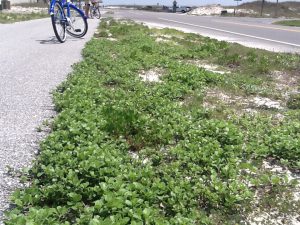
Vitex beginning to take over bike path on Pensacola Beach. Photo credit: Rick O’Connor
We tried to educate the property owners about the issue based on what we learned in South Carolina, where there is a state task force to battle the plant, and suggested methods of removal. Many property owners began the process, which can take several treatments over several years, and, with the help of University of West Florida students, removed all of the vitex from public land on Santa Rosa Island. We were feeling good that we might still be able to eradicate this plant from our county… and then I went for a hike in the Gulf Islands National Seashore… yep… found more… almost 10,000 m2 of the plant. UWF and Sea Grant have worked hard over the past year to remove these plants, and have removed all but one section. Recently I received an email letting me know that it was found in Franklin County. They have since logged this on EDDmaps and have begun the removal process. However, this begs the question… where else might this plant be in the panhandle?
Beach vitex (Vitex rotundifolia) is a salt tolerant plant that does well in dry sandy soils and full sun; it loves the beach. We have found it in dune areas above the high tide line. It was brought to the United States in the 1950’s for herbarium use. By the 1980,’s the plant was used in landscaping and sold at nurseries. It was first used in dune restoration in South Carolina after Hurricane Hugo, and that was when the trouble began.

Vitex growing at Gulf Islands National Seashore that has been removed. Photo credit: Rick O’Connor
The plant grows very aggressively during the warmer months. It out competes native dune plants and quickly takes over. Growing 2-3 foot tall, this woody shrub has above ground rhizomes that can extend over 20 feet. Secondary roots begin to grow from the nodes along these rhizomes and it quickly forms an entangled mat of vines that blocks sun for some of the native plants. There has also been concern for nesting sea turtles. The rhizomes can over take a nest while incubation is occurring and entrapping the hatchlings. The plant has become such a problem in both North and South Carolina that a state task force has been developed to battle it. Vitex can spread either vegetative or by seed, both can tolerate being in salt water and can be dispersed via tides and currents. The plant has 1-2” ovate leaves and violet colored blossom, which can be seen in late spring and summer. The leaves become a rusty gray color during winter. The seeds, which are found in late summer and fall, are spherical and gray-purple in color. Vitex produces many seeds, an estimated 22,000/m2, and – in addition to being carried by the tide – can be transported by birds as well.
Again, we are hoping that the plant has been discovered early enough to control, if not eradicate, it… HOWEVER, WE NEED YOUR HELP. If you think you may have seen this plant along your coasts, please contact your county Sea Grant Extension Agent for advice on how to manage it.









